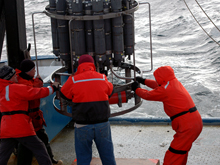
Mike Kong, Vladimir Bakhmutov, Dan Torres, and Russ Hopcroft help guide the swinging rosette to its pallet during a swell. The rosette weighs 760 pounds even without bottles or instruments and is deployed and recovered by a winch-wire. During heavy seas or a swell, the rosette can be hard to control, both on deck and in the water. Click image for larger view and image credit.
Beyond Operator Error
September 15, 2009
Christine Patrick
Public Affairs Specialist
NOAA's Office of Ocean Exploration and Research
I was sure my timing was off. As I filmed scientists deploying their equipment over the last day, I was foiled time and again. A 10-minute segment following the HAPS core sampling culminated in two empty containers. An equally long segment dealing with the beam trawl ended with a team straining to pull in an overfilled net — containing, therefore, a meaningless sample.
Scientists’ gear and methodologies have been previously tested and proven. Although they are gathering samples at stations at any hour of the day or night, they are definitely paying attention. Communication with the Russian crew is working fine, thanks to the help of some translators and a week of practice. Access to Russian waters in the East Siberian Sea and Chukchi Sea is something these scientists value highly and take seriously. So what is going wrong?
Call it the uncontrollable natural element. The HAPS core sampler automatically opens when it hits the bottom, releasing tension on the tether — but a set of slow rolling surface waves, known as a swell, can accidentally trigger it on the way down. The going is as tough for the other core sampler onboard, the Russians’ three-meter-long (9.8-foot-long) "beast" that can only be deployed correctly with the help of three or four men, in addition to the winch. To bring back a full sample, it must sink vertically through soft sediment, but can be stymied by a swell, the drift of the ship, and even an errant rock on the seafloor.
Swell can also affect the rosette, which contains the conductivity-temperature-depth (CTD) instrument and a number of bottles that collect water samples. The bottles are remotely opened to collect water at various depths, but a three-to-five foot swell can make a one-meter-from-bottom water sample something closer to two or three meters from the bottom. The water is not necessarily safe on deck, either: once the bottles are opened and scientists drain the samples into their own smaller sample bottles, even a heavy mist in the air can “contaminate” the sample and alter how much CO2 shows up in analysis.
An overfilled beam trawl net means the sample might not be representative, as it may have filled early, excluding organisms it would have collected toward the end of the trawl. The only solution is to haul in and empty the terrifically heavy net, and then trawl again for a shorter length of time. There is also the possibility the nets won't return at all, if large rocks on the seafloor tear them. The 2004 RUSALCA expedition helped establish that much of the sediment up here is muddy or sandy, but the risk of snags always lurks.
The bongo nets, so called because their large circular frames resemble bongo drums, have water flow meters that report the water volume that corresponds with that sample of zooplankton or larval fish. But in a strong wind or freezing temperatures, the meters can start acting funny, and under- or over-report the volume. The zooplankton sample from the bongo nets is also in question if the ship drifts while the nets are deployed; a less-than-vertical path through the water means a potentially unrepresentative sample of that water column. Ship drift can also affect the speed of the Russians’ remotely operated vehicle, making video footage hard to process.
So far, the only gear that has provided successful samples every time is the van Veen grab, a metal claw that leaves the deck open and comes back clutching seafloor sediments. But there are 19 days left in the mission — enough time, perhaps, for nature to find an altogether new way to intervene.















